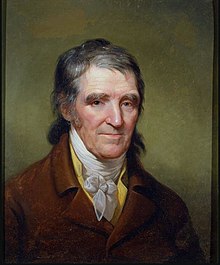William Findley

William Findley (* 1741 or 1742 in the province of Ulster , Ireland ; † April 4, 1821 near Greensburg , Pennsylvania ) was an American politician . Between 1791 and 1799 and again from 1803 to 1817 he represented the state of Pennsylvania in the US House of Representatives .
Career
William Findley attended public schools in his Irish homeland. He came to Philadelphia in 1763 . After a few stops, he came to Westmoreland County . In the 1770s he joined the American Revolution . He took part in the war of independence as a soldier in the militia and rose to become captain. Then he worked as a weaver. At the same time he embarked on a long political career in Pennsylvania. Between 1784 and 1787 he was a member of the state legislature; in 1789 and 1790 he was a member of the State supreme executive council of Pennsylvania . He was then a member of the House of Representatives from Pennsylvania from 1790 to 1791 . In 1790 he also took part in a constitutional convention of his state as a delegate. Politically, he was an opponent of the federal government under President George Washington . He later became a member of the Democratic Republican Party founded by Thomas Jefferson in the late 1790s .
In the congressional elections of 1790 Findley was elected in the eighth constituency of Pennsylvania in the US House of Representatives, which was then still in Philadelphia. After three re-elections, he was able to complete four legislative terms in Congress by March 3, 1799 . Since 1795 he represented the then newly established eleventh district of his state there. During the Whiskey Rebellion of 1794, he tried to mediate between the parties to avoid further escalation.
After his time in the US House of Representatives, William Findley worked in agriculture. He served in the Pennsylvania Senate from 1799 to 1802 . In the congressional elections of 1802 he was elected as a candidate for the Democratic Republicans again in the eighth district of his state in Congress in Washington, DC . After six re-elections, he was able to complete seven further terms in the US House of Representatives by March 3, 1817. During this time, the Louisiana Purchase made by President Jefferson in 1803 significantly expanded the territory of the United States. In 1804 the twelfth amendment was ratified. Since 1812, the events of the British-American War also shaped the work of Congress. William Findley was a staunch supporter of Presidents Thomas Jefferson and James Madison . Between 1803 and 1813 he headed the election committee. From 1813 he represented the eleventh electoral district of Pennsylvania in Congress.
After his final resignation from Congress in 1817, William Findley was no longer politically active. He died on April 4, 1821 on his estate near Greensburg.
Web links
- William Findley in the Biographical Directory of the United States Congress (English)
- William Findley in the database of Find a Grave (English)
| predecessor | Office | successor |
|---|---|---|
| new constituency |
United States House Representative for Pennsylvania (8th constituency) March 4, 1791 - March 3, 1795 |
Thomas Hartley |
| new constituency | United States House Representative for Pennsylvania (11th constituency) March 4, 1795 - March 3, 1799 |
John Smilie |
| John Stewart | United States House Representative for Pennsylvania (8th constituency) March 4, 1803 - March 3, 1813 |
William Piper |
| Abner Lacock | United States House Representative for Pennsylvania (11th constituency) March 4, 1813 - March 3, 1817 |
David Marchand |
| personal data | |
|---|---|
| SURNAME | Findley, William |
| BRIEF DESCRIPTION | American politician |
| DATE OF BIRTH | 1741 or 1742 |
| PLACE OF BIRTH | Ulster Province , Ireland |
| DATE OF DEATH | April 4, 1821 |
| Place of death | near Greensburg , Pennsylvania |